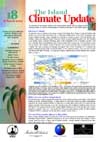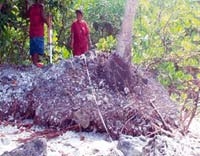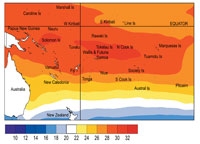Climate developments in April 2007

Outgoing Long-wave Radiation anomalies for April 2007. (Click for enlargement and detail)
The South Pacific Convergence Zone (SPCZ) was generally further north than usual, extending from Papua New Guinea to Tuvalu, and then towards Niue. A region of weakly enhanced convection occurred over Vanuatu, Tuvalu, Fiji, and Tonga. A region of weakly suppressed convection and low rainfall existed over parts of Eastern Kiribati, Tokelau, the Northern Cook Islands, Samoa, and the Marquesas Islands.
Rainfall was above average (at least 150% of normal) throughout southern Tonga, and at least 125% of normal in parts of Fiji. However, rainfall was low, (50% or less of normal) in much of Northern French Polynesia, and also below average (75% or less of normal) throughout much of New Caledonia.
April mean air temperatures were about 1.0 °C above average in Samoa, Northern French Polynesia, and 0.5 °C above average in Tuvalu, Tonga, Niue, Central French Polynesia.
Tropical Southwest Pacific mean sea-level pressures were above average west of New Caledonia and Vanuatu, and near average over many Southwest Pacific Islands. Equatorial surface easterlies occurred in 97% of observations at Tarawa.
| Country | Location | Rainfall (mm) | % of average | Comments |
|---|---|---|---|---|
| Fiji | Lakeba | 523 | 254 | Record high |
| Tonga | Lupepau’u | 579 | 277 | Extremely high |
Soil moisture in April 2007

Estimated soil moisture conditions at the end of April 2007, using monthly rainfall data. (Click for enlargement and detail)
Estimates of soil moisture shown in the map (right) are based on monthly rainfall for one station in each country. Currently there are not many sites in the water balance model. It is planned to include more stations in the future.
The information displayed is based on a simple water balance technique to determine soil moisture levels. Addition of moisture to available water already in the soil comes from rainfall with losses via evapotranspiration. Monthly rainfall and evapotranspiration are used to determine the soil moisture level and its changes.
Please note that these soil moisture calculations are made at the end of the month. For practical purposes, generalisations were made about the available water capacity of the soils at each site.
At the end of April 2007, Tarawa, Apia, Nadi, Nuku’alofa, Hanan, and Rarotongan soils were at field capacity (full).
El Niño/Southern Oscillation (ENSO)

Sea surface temperature anomalies (°C) for April 2007. (Click for enlargement and detail)

Mean sea surface temperatures (°C) for April 2007. (Click for enlargement and detail)
Conditions in the tropical Pacific are currently neutral with the chances of La Niña developing remaining elevated.
The pattern of sea surface temperature (SSTs) anomalies is beginning to resemble La Niña conditions with colder than average waters in the far eastern Pacific and slightly warmer than average waters in the western Pacific. SSTs remain slightly above normal to the west of the Date Line, with below average SSTs extending from the South American coast to 130°W.
The NINO3 anomaly cooled to –0.1°C in April (February–April average around +0.1°C) while the NINO4 anomaly was +0.4°C in April (February–April mean around +0.5°C).
The Southern Oscillation Index (SOI) is still negative, but in the neutral range.
Subsurface data for April shows that negative anomalies in the top 150 metres between the Date Line and the South American coast continued over the last month and moved westwards.
The easterly trade winds during April have been near normal in the eastern Pacific, but slightly stronger than normal in the central and western Pacific.
Outgoing longwave radiation and tropical rainfall anomalies for April indicate continued enhanced convection in the South Pacific Convergence Zone (SPCZ) and west of the Date Line and a double-ITCZ (Inter-Tropical Convergence Zone) structure east of the Date Line.
The global sea surface height (SSH) anomaly shows a classic La Niña pattern with lower SSH anomalies from the Date Line east, surrounded by a horseshoe of higher SSH anomalies in the western Pacific. The Madden-Julian Oscillation is presently very weak, with no discernable phase.
The dynamical models show a transition to La Niña conditions over the next 3 months, with this persisting for the remainder of the year, whilst the statistical models project neutral ENSO states for the next 6–9 months.
No model retains warm conditions during the remainder of the year. The NCEP synopsis suggests a transition from ENSO-neutral to La Niña conditions is possible within the next 2–3 months, while the IRI synthesis gives a probability of 50% for a La Niña by mid-year. The probability of El Niño conditions re-emerging during the forecast period remains at or below 5%.
Forecast validation: February to April 2007
A large region of enhanced convection and above average rainfall was expected over Western and Eastern Kiribati, Tuvalu, Tokelau, Wallis and Futuna, and the Northern Cook Islands, with average or above average rainfall affecting the Solomon Islands, the Southern Cook Islands, and the Society and Austral Islands. Suppressed convection and below average rainfall was expected over New Caledonia, with near or below average rainfall in Vanuatu, Fiji, Tonga, the Tuamotu and Marquesas Islands, and Pitcairn Island. Near average rainfall was expected elsewhere.
A large region of enhanced convection and/or above average rainfall extended from the region northeast of Papua New Guinea southeast to the Southern Cook Islands, including the Solomon Islands, Vanuatu, Fiji, Tonga, Niue, and Samoa. This region was further south than expected. Suppressed convection or/or below average rainfall occurred over Eastern Kiribati, Tokelau, the Northern Cook Islands, and Northern French Polynesia, as well as New Caledonia. Rainfall was higher than expected in Vanuatu, Fiji, Tonga, and Niue, and lower than expected in Western and Eastern Kiribati, Tuvalu, and Tokelau. The ‘hit’ rate for the February–April 2007 rainfall outlook was about 50%.
